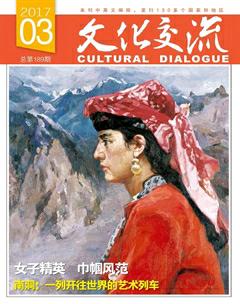冯其庸走完风雨学术路
李萌昕
2017年1月22日,著名文史专家、红学家冯其庸在北京安详离世,享年93岁。中国学界又失去一位学术精英。
就在他去世前不久,商务印书馆出版了他的口述自传《风雨平生》,这是冯其庸生前出版的最后一部著作。在书中冯先生历述风雨平生,尤其是详细回顾了他丰富而不平凡的学术生涯。他学术成果斐然,被业界誉为一代学术大师。
有一张难得一见的老一辈红学家合影,包括蓝翎、李希凡、冯其庸、周汝昌、俞平伯、吴世昌、吴恩裕。目前在世的只剩下李希凡了。90岁高龄的李希凡在得知冯其庸去世的消息后悲痛不已。著名的《红楼梦大辞典》就是冯其庸和李希凡合作编著而成。
妙笔搜求红学奥义
冯其庸,名迟,字其庸,号宽堂。1924年2月3日生,江苏无锡县前洲镇人。靠着努力和勤奋,他从著名的无锡国专毕业。1954年入职中国人民大学。曾任中国人民大学教授、中国艺术研究院副院长、中国红学会会长、中国戏曲学会副会长、《红楼梦学刊》主编等职,以研究《红楼梦》闻名于世,因主持校订《红楼梦》而成一代红学大家。
冯其庸还著有《曹雪芹家世新考》《论庚辰本》《梦边集》《漱石集》《秋风集》等专著二十余种,并主编《红楼梦》新校注本、《红楼梦大词典》《中华艺术百科大辞典》等书。
“红楼奥义隐千寻,妙笔搜求意更深。
地下欲请曹梦阮,平生可许是知音。”
从冯其庸赠友人的诗中或可窥见他一生结缘红楼的心境。
在对照求证下,冯其庸“挖”出了《红楼梦》的诸多经典之美。他发现《红楼梦》含蓄、不直說,有内涵、有隐喻,欲言还休。他赞叹《红楼梦》最了不起的是里面描写的人物都是独特的,个性鲜明突出。
1982年3月,人民文学出版社推出由中国艺术研究院红楼梦研究所校注的《红楼梦》。这个校注本始于1975年,由吴世昌、吴恩裕、吴组缃、周汝昌、启功等老红学家担任校注工作的顾问,全书的校注工作由冯其庸总负责,从那之后,这个版本的《红楼梦》就广受学界与读者认可,并成为通行的《红楼梦》版本,影响了几代读者。新校注本《红楼梦》于1994年和2007年进行了两次全面修订。根据最新统计,这个校注本的《红楼梦》已累计发行近500万套,是当下相当严谨、普及的版本。
现任中国红楼梦学会会长张庆善是冯其庸的学生,两人相识近40年,“他是我的老师,我是他的兵,这都多少年了。”张庆善认为,冯老在红学方面的贡献大致有三,其一是他本身的学术成就,如对曹雪芹祖籍、家世的研究,对《红楼梦》版本的研究等,新时期红学具有一些奠基性的学术成果,都是在冯其庸先生的领导下完成的。其次他对中国红学的创建功不可没,他创立了红楼梦学会和学刊,“让当代有了一个研究红学的机构和刊物,是非常了不起的事情”。此外,冯老从1979年起就组织和推动《红楼梦》走向国际,多年来致力于在国际社会推广《红楼梦》,让这部名著走向了世界。
81岁的中国红楼梦学会常务理事吕启祥也与冯老交往多年,1982年版《红楼梦》初版就是由冯其庸、林冠夫、吕启祥三位负责。1994年修订再版,再次请到三位,冯其庸是总负责人。吕启祥听闻冯老去世的消息,用八个字概括他的人生:“风雨长途,笔底乾坤。”
行走的学者 不凡的人生
冯其庸创建中国人民大学国学院,提出“大国学”新概念,81岁时纵穿罗布泊。他十赴新疆,三上帕米尔高原,又穿越米兰、罗布泊、楼兰、龙城、白龙堆、三陇沙入玉门关,查实了玄奘自于阗回归长安的最后路段。他在治学方面重视文献记载、重视地面遗迹的调查、重视地下发掘的新资料,三者互相印证,才作定论,这一颇有难度的学术路径在他口述自传中得到充分的展示。
吕启祥认为,冯其庸先生以将近一个世纪的生命长途,以“行走天地间”、遍历名山大川涉险求真的坚实脚印,造就了一个文化学术的传奇。以三十三卷逾千万字的著述和量多质优的书法、绘画及摄影作品,收乾坤于笔底,气象万千。吕启祥认为:“冯其庸是学问家、艺术家、旅行家,却又不止于此,三者往往是叠合的、交叉的,分割开来就失去了冯其庸。难怪人们觉得概括冯其庸的成就是个难题,哪个称号对他都不尽合适、容纳不下。”
2017年1月,冯其庸50年前以小楷抄写的16卷《瓜饭楼抄庚辰本石头记》和《风雨平生:冯其庸口述自传》两种新书亮相。这本自传是冯其庸先生口述,由国家图书馆中国记忆项目中心录音后转换成文,经传主5次修改、最终定稿的,简明而生动地叙述了冯其庸先生90多年来所经历的风雨学术路。该书的编辑透露,还记得“先生收到刚刚出版的书时激动不已的神情”。据悉,《论红楼梦思想》增订版、《论庚辰本》(增补本)等冯其庸著作也即将由商务印书馆陆续推出。冯其庸的散文集《人生散叶》正在编辑过程中,很快就要出版。
冯其庸还在研究中国文化史、古代文学史、戏曲史、艺术史等方面获得了成就。冯其庸的学术道路中,影响深远的《历代文选》是其中浓墨重彩的一笔。此书后来由中国青年出版社出版发行,目前还不断再版重印,累计发行70万余册。《历代文选》所选散文共150篇,上起先秦、下至清末,多为历代传诵的脍炙人口的作品。这套文选思想性、文学性兼具,注释严谨,是古代散文选中较好的选本。
与一般学者显著不同的是冯其庸书画创作的成就。他的书法为业界和收藏界推崇,他的画被誉为真正的文人画,率意而纯真,寥寥数笔便能全其气韵神采,一切无不显露其学养功底。冯其庸的画远追青藤(徐渭)、白阳(陈淳),近受齐白石、刘海粟、朱屺瞻的影响,但又表现出与前辈们不尽相同的艺术特征,他更重“聊写胸中逸气”。他的印章也经常随着书画作品出现在人们的视野中。
冯其庸在书法方面的造诣颇深,早年临写名家各派,但最喜欢的是行书,尤其钟情于王羲之的《圣教序》,不仅收集了《圣教序》的各种佳拓的影印本和明拓残本,而且反复临写右军存世的各种书札,以右军书法建构了自己的书法气场,显得神清气朗,意远韵长:文气勃发,雅致四溢。他的书法风格,潇洒而不失法度,清秀而远离流俗。更为可贵的是在他的书法中有时又反映出绘画的谋篇布局和笔墨韵致,表现出中国书画在两种艺术形式创作中相互作用的关系,也论证了书画同源的道理。
馮其庸还研究了中国大西部的历史文化艺术,著有考证丝绸之路和玄奘取经之路的大型摄影图册《瀚海劫尘》,获得学术界的高度评价。
Nation Mourns the Death of Scholar
By Li Mengxin
On January 2017, Feng Qiyong, a prominent scholar of history and culture and an authority on , a classical novel of the Qing Dynasty (1644-1911), passed away in Beijing at the age of 93.
Shortly before his demise, Commercial Press published his oral autography titled , the last book of his lifetime.
Feng Qiyong was born on February 3, 1924 in Qianzhou Town, Wuxi, Jiangsu Province in eastern China. He was a graduate from Wuxi School of Chinese Classics, a unique institution much honored and appreciated in modern history of Chinese education. In 1954 he came to work at China Peoples University in Beijing.
A scholar of , Feng is best known for the annotated edition of the classical novel. A group of scholars headed by Feng Qiyong started preparing an annotated edition in 1975 and it was published in March 1982 by the Peoples Literature Press. The novel was revised twice in 1994 and 2007, all under the leadership of Feng Qiyong. The annotated edition has stood the wear and tear of time and has been widely recognized by experts and common readers. The latest data indicates that nearly 5 million copies have been sold.
Zhang Qingshan, the incumbent president of China Society of Studies of The Dream of Red Chambers, speaks highly of Feng. They knew each other for nearly 40 years. Zhang comments that Fengs contribution to the studies of the classical novel is threefold. First of all, Feng had a masterful knowledge of the author Cao Xueqins life and ancestors. He was remarkably versed in various ancient editions of the novel. Some pioneering studies that paved way for new studies of the novel were done under his leadership. Secondly, he founded a society for scholars who study the novel to come together to share their separate analyses and studies and join hands in any way that satisfy their imagination and passion. He also launched an academic journal dedicated to publishing papers in the studies of the novel. Thirdly, Feng promoted the novel to international readers as of 1979. Nowadays, the novel is widely appreciated in the world.
In other fields of academic studies, Feng was also an achiever. He studied the histories of culture, literature, theater and art of ancient China. Selected Essays of Different Dynasties, a book he compiled and edited, speaks highly of his insight and knowledge of ancient Chinese essays. It features 150 essays from the pre-Qin period up to the end of the Qing Dynasty, spanning about 2,000 years. The book was published by China Youth Press. With various reprints, more than 700,000 copies have been issued. It is considered as one of the best anthologies of ancient essays.
Feng Qiyong was more than a scholar. He was a traveler and photographer. He traveled across Xinjiang ten times and did thorough textual studies and field studies until he concluded that the route Monk Xuanzhuang had taken through Xinjiang on his way back to the central empire from India. Academically, he emphasized the integration of scholarly studies, field studies and unearthed archaeological evidence as the only foundation of answers to historical puzzles. , a collection of photographs he took of the Silk Road and the routes Monk Xuanzhuang took to and from India, is academically acclaimed.
Feng was also a calligrapher and painter. His calligraphy is highly valued by his friends and collectors. His painting is acclaimed as a true presentation of the literati style. His portraits remind of the ancient and modern masters such as Xu Wei, Chen Chun, Qi Baishi, Liu Haisu and Zhu Qizhan.

